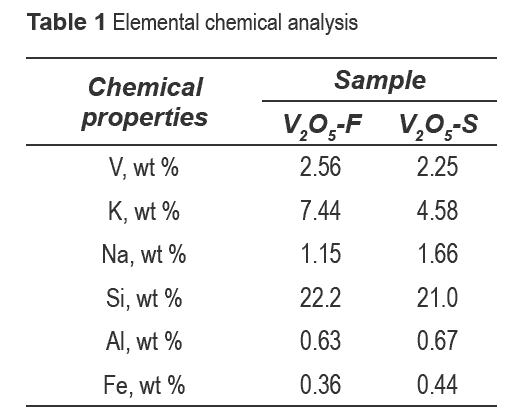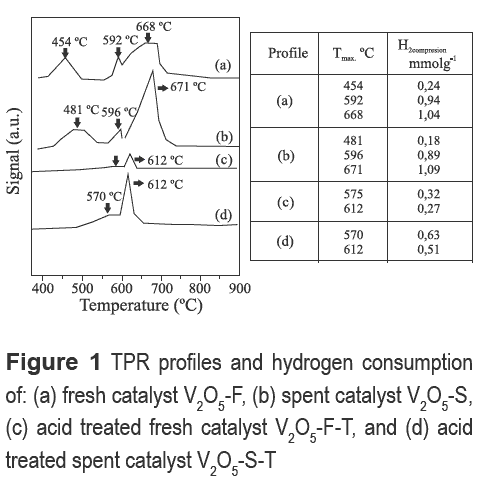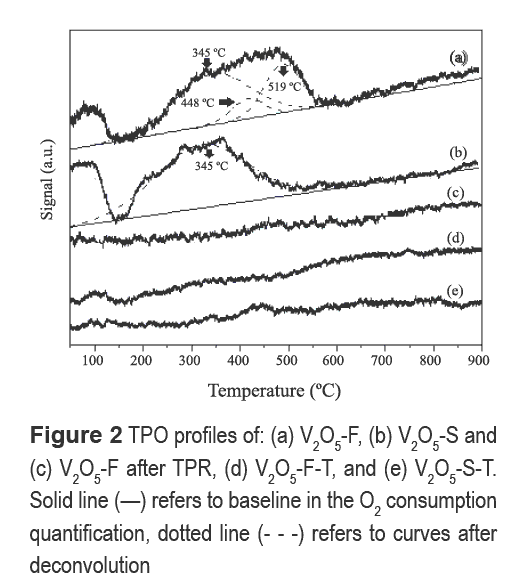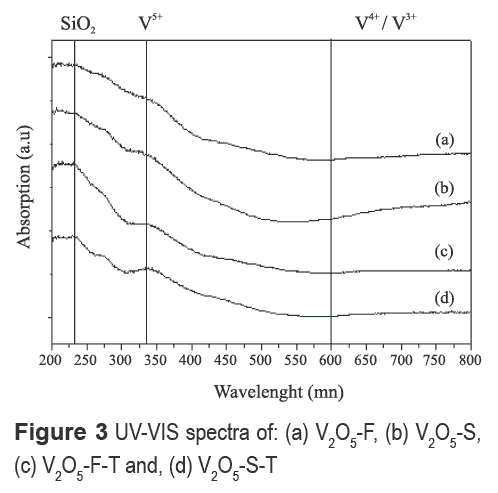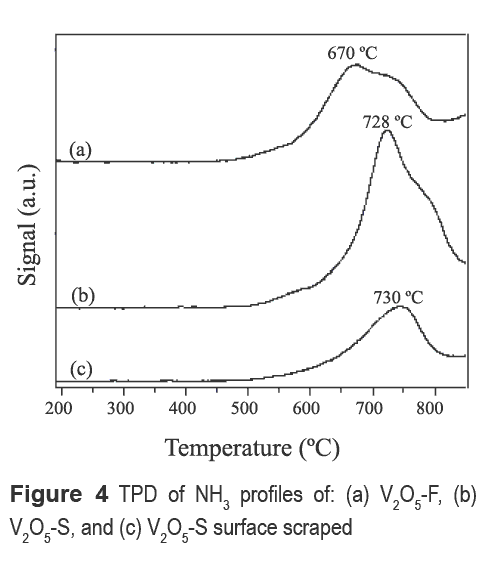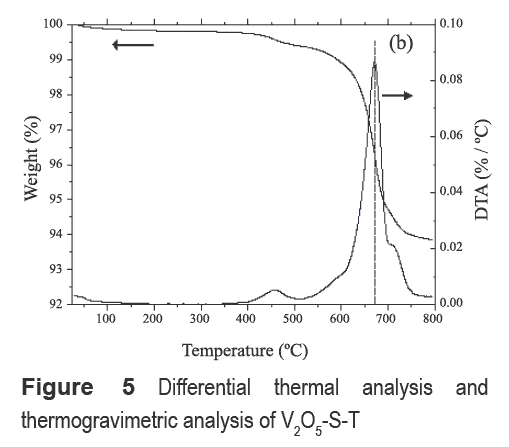Serviços Personalizados
Journal
Artigo
Indicadores
-
 Citado por SciELO
Citado por SciELO -
 Acessos
Acessos
Links relacionados
-
 Citado por Google
Citado por Google -
 Similares em
SciELO
Similares em
SciELO -
 Similares em Google
Similares em Google
Compartilhar
Revista Facultad de Ingeniería Universidad de Antioquia
versão impressa ISSN 0120-6230versão On-line ISSN 2422-2844
Rev.fac.ing.univ. Antioquia n.57 Medellín jan./mar. 2011
Characterization by temperature programmed techniques of spent and acid treated vanadium catalysts
Caracterización por técnicas de la temperatura programada de catalizadores de vanadio desactivados y tratados con ácido
Iran David Charry, Lina María González*, Consuelo Montes de Correa
Environmental Catalysis Research Group. Universidad de Antioquia. Sede de Investigación Universitaria- SIU. A.A. 1226, Calle 62 N° 52-59. Medellín, Colombia
Abstract
Spent samples of V2O5/SiO2-γAl2O3 catalyst used for H2SO4 production were acid treated to recover vanadium. Fresh, spent, and acid treated samples were characterized by temperature-programmed techniques: TPR-H2, TPO-O2, TPD-NH3 and, TGA-DTA in order to determine the effect of deactivating species on vanadium recovery. DRX and UV-Vis techniques were used to confirm several signals from the temperature-programmed profiles. The results suggest that vanadium sulfovanadates and oxides in treated samples strongly interact with the support making it difficult to get more than 86% vanadium recovery.
Keywords: V2O5 catalyst, catalyst deactivation, vanadium recovery, sulfovanadate species, temperature-programmed techniques.
Resumen
Muestras de V2O5/SiO2-γAl2O3 desactivado durante la producción de ácido sulfúrico se trataron con ácido con el fin de recuperar el vanadio. Los materiales se caracterizaron mediante técnicas de temperatura programada: TPR-H2, TPO-O2, TPD-NH3, y TGA-DTA con el fin de determinar el efecto de las especies responsables de la desactivación en la recuperación del metal. Análisis por DRX y UV-Vis se utilizaron para confirmar algunas señales obtenidas en los perfiles de temperatura programada. Los resultados sugieren que la presencia de sulfovanadatos y óxidos de vanadio en las muestras tratadas hacen difícil recuperar más del 86% del vanadio presente en las muestras de catalizador.
Palabras clave: Catalizador V2O5, desactivación de catalizadores, recuperación de vanadio, sulfovanadatos, técnicas de temperatura programada.
Introduction
The catalyst V2O5/SiO2-γAl2O3 has been widely used for the oxidation of SO2 to SO3 to commercially produce sulfuric acid [1, 2]. In spite of its high catalytic activity, it is slowly deactivated under reaction conditions (temperatures between 450 and 600 °C) [3, 4]. Characterization of spent V2O5/ SiO2-γAl2O3 samples evidenced the formation of some species of vanadium V4+, such as: K4(VO)3(SO4), KV(SO4)2, Na2VO(SO4) and Na4(VO)2O(SO4)4 [5], which are very stable [1,2]. The disposal of deactivated vanadium catalysts has turned on an environmental problem in recent years due to its toxicity [6]. Recycling of some catalyst components, such as vanadium, silica, and alumina has been recommended instead of catalyst disposal. Additionally, the recovery of vanadium from spent catalysts is considered an additional source of vanadium, which has a large commercial demand [2]. Although several methods have been proposed for vanadium leaching from spent catalysts leading to around 90 % wt. vanadium recovery [2-9], most of them involve the use large quantities of leaching agents, are too expensive, or use hazardous organic solvents, leading to the formation of vanadium chlorides. Previously, we reported a clean and economical method for vanadium leaching from spent V2O5/SiO2-γAl2O3 commercial catalyst using a 10 % vol. H2SO4 at room temperature obtaining 86 % wt. vanadium recovery [6]. The goal of this work is to characterize commercial samples of fresh (V2O5-F) and spent (V2O5-S) vanadium catalysts by temperature programmed techniques. Temperature-programmed reduction and oxidation (TPR-H2 and TPO-O2) shed light of a possible reduction of the active phase and the formation of oligomeric vanadium species. Ammonia temperature-programmed desorption (TPD-NH3) and thermogravimetric analyses (TGA-DTA) were used to identify sulfovanadates formed with the alkali promoted metals. Likewise, experiments of oxidation-reduction cycles (TPO/ TPR) were carried out as a possible reactivation method. In addition, complementary techniques such as X-Ray Diffraction (XRD), and UV-VIS Diffuse Reflectance were used. The formation of sulfovanadates and the interaction of vanadia with the support are important for the efficiency of vanadium recovery.
Experimental
Catalyst materials
The ring shaped fresh and used vanadium catalyst samples were supplied by Industrias Básicas de Caldas S.A from Monsanto Enviro-Chem Systems, Inc., USA (ref. LP110). Table 1 shows the chemical analysis of fresh and spent catalyst samples.
Samples of non-supported vanadium oxide and supported over silica, γ-Al2O3 and silica/γ-Al2O3 mixture were prepared for identifying specific signals of the temperature-programmed profiles. V2O5 was prepared using NH4VO3 (11 mmol) dissolved in 11.5 mL of oxalic acid (0.91 M). The resulting solid was dried at 100 °C and calcined at 550 °C for 8 h in a muffle furnace. VO2 was prepared by reduction of V2O5 in 4.47 % H2/Ar at 700 °C for 30 min. V2O5 supported on SiO2, γ-Al2O3 or γ-Al2O3/SiO2 (weight ratio 1:40) samples were prepared by the precipitation of ammonium metavanadate (9.5 mmol) in a suspension of the support (1 g) in 5 mL of oxalic acid (0.91 M). The excess water was eliminated by evaporation in a rotavap and the solid finally dried at 100 °C for 16 h, and calcined at 450 °C for 8 h in a muffle furnace.
Catalyst characterization
Temperature-programmed experiments were carried out in a Micromeritics Autochem II equipped with a thermal conductivity detector (TCD). Catalyst samples were loaded in a U-type quartz reactor of 0.95 cm diameter. Before TPR or TPO experiments 50 mg samples were pretreated during 60 min at 100 °C under flowing argon (50 mL/min) [8] and then cooled to 40 °C. The TPR and TPO analysis were carried out at 900 °C at a heating rate of 5 °C/min in flowing 4.47 % H2/ Ar or 5.36 % O2/Ar, respectively (50 mL/min). In order to evaluate the re-oxidation capacity of vanadium reduced species TPO analysis of fresh catalyst samples previously reduced at 600 °C (highest oxidation temperature of SO2 to SO3 [1,2]) was carried out during 120 min in flowing 4.47 % H2/Ar. During TPD-NH3 experiments the samples were manipulated under nitrogen atmosphere. Before the analysis, the sample (around 50 mg) was heated at 500 °C in flowing helium for 30 min. After cooling, the sample was treated in flowing 3 % NH3/He (50 mL/min) for 90 min and then 30 min in flowing Argon (30 mL/min). Then, the sample was heated (10 °C/ min) to 1100 °C. An additional analysis was performed to a surface scraped sample of spent catalyst to evaluate the possible deactivation by the formation of superficial sulfates. The thermogravimetric and differential thermal measurements (TGA-DTA) were carried out on a Universal V2.5 TGA equipment. Samples were heated (10 °C/min) in air at temperatures between 25 and 800 °C. X-ray diffraction (XRD) patterns were collected (5° < 2θ < 60°) in a Rigaku Miniplex equipped with a Cu lamp. UV- VIS diffuse reflectance spectra were collected in the range 200 - 800 nm in a Lamda 4B Perkin Elmer spectrophotometer equipped with a diffuse reflectance attachment using BaSO4 as reference.
Leaching of vanadium with sulphuric acid
Finely ground samples (1 g) of fresh (V2O5-F) and spent (V2O5-S) commercial catalyst were treated with a solution of 10 vol %. H2SO4 (20 mL) at room temperature [9,10]. Then a 30 wt. % solution of H2O2, was added up to a pH between 6 and 7. The final solution was stirred for 2 hours. Treated materials were coded as V2O5-F-T and V2O5-S-T, respectively.
Results and discussion
H2-TPR
Different types of oxidized species on vanadium catalysts [11,12] were identified. TPR profiles of fresh, spent and acid treated catalyst samples and their hydrogen consumption are shown in figure 1.
The fresh catalyst sample, figure 1a, exhibits a peak at 454 °C associated with the reduction of polyvanadate species bonded to catalyst alkali promoters: sodium and potassium [13,14]. The shift to 481 °C, figure 1b, observed in a spent catalyst sample can be attributed to the formation of sulphovanadates on the catalytic surface, such as KV(SO4)2 K4(VIVO)3(SO4), K2VIVO(SO4)3, Na2VIVO(SO4)2, Na3(VO)2(SO4)4 and K3(VO)2(SO4)5*, where (*) refers to a mixture of V5+ y V4+ compounds [3,15-18]. Formation of those compounds is favored by the presence of pyrosulfates S2O72-, which not only act as active intermediate species in the oxidation of SO2 to SO3 [2,15,16], but also in the sulphovanadate precipitation over the catalytic surface leading to catalyst deactivation [16,17].
An enhanced effect of the support (γ-Al2O3- SiO2) in the reduction of V2O5 is evidenced by a consumption peak around 590 °C (Figs 1a and 1b) associated to the formation of V6O13 [18-20]. Unsupported V2O5 shows a signal at 640 °C. The shift to lower temperature observed in the supported sample is attributed to support interaction [18]. Notwithstanding, γ-Al2O3 is able to stabilize the reduced forms of vanadium, mainly V4+ compounds V-O-Al, during the deactivation of the catalyst as the signal remains in the spent catalyst, figure 1b, [21-23]. The peak around 670 °C is associated to the reduction of monomeric, polymeric, and crystalline VOx species which coexist on the surface as: V3O7, V4O9, V6O13 and V2O5 [7, 13, 21, 24-26]. Thus, this peak appears to be a superposition of different reduction steps of these species [18]. When catalyst samples were treated with H2SO4 (Figures 1c and 1d) the strong interaction between vanadium species and the support are evidenced since the signals around 570 and 612 °C remained.
TPO
TPO analysis was used to evaluate the oxidation of spent catalyst samples as a possible regeneration method. TPO of V2O5-F samples after TPR are shown in figure 2. After deconvolution of the signal, the fresh sample exhibits three oxidation peaks at 345 °C, 448 °C and 519 °C, figure 2a. The peaks at 448 °C and 519 °C are associated to the oxidation of VO2 and V6O13 coexisting with V2O5, as shown in reaction 1 [6,19,24,25]. Similar to TPR experiments, the lower oxidation temperature compared to unsupported VO4 is associated with the interaction between the support and VOx species [18].

The peaks around 345 °C exhibited by the fresh and spent catalyst samples are associated with the reoxidation of VOx most probably crystalline species [24]. The higher oxygen consumption of the spent catalyst sample compared with the fresh one could be attributed to the sinterization and formation of sulphovanadates of sodium and potassium during H2SO4 production [3,15-18,27]. Moreover, the oxidation of the fresh catalyst sample reduced at 600 °C, figure 2c, suggests that reduced vanadium compounds (V4+) are stable compared to the pentavalent initial state making it difficult catalyst re-activation. Figures 2d and 2e show that remaining vanadium species seem to be stable to oxidation since negligible oxygen consumption was observed.
UV-VIS results, figure 3, confirm the oxidation states of vanadium and the strong interaction with the support [22]. A broad band close to 250 nm corresponds to the SiO2 support, and a shoulder around 350 nm is assigned to the ligand to metal charge transfer (LMCT) band of V5+ [20, 22, 28] confirming the presence of V2O5-K-SiO2. The d-d electron transition band of V4+/ V3+ is found in the range 600 - 800 nm [20,22], and the absorption increased due to the presence of sulphovanadates in the spent sample, figure 3b.
TPD-NH3
Figure 4 shows ammonia TPD profiles of V2O5-F, V2O5-S, and V2O5-S surface scraped samples. These samples exhibit a well resolved desorption peak in the range 670-730 °C assigned to a mixture of strong Lewis and Brönsted acid sites. The Lewis sites are unsaturated VO2+ vanadyls, and the Brönsted sites are associated with V-OH and the specific acidic properties of the support [22,29]. However, the increase of ammonia desorption of the spent sample compared to the fresh one, figure 4a and 4b, confirms the deposition of sulfate ions through the formation of sulfovanadates during the reaction. Furthermore, TPD-NH3 of scrapped surface of a spent catalyst sample, figure 4c, evidences the formation of sulfovanadates.
Vanadium recovery
TPO analysis after TPR confirms the irreversibility of vanadium catalyst deactivation. Therefore, the recovery of vanadium becomes a good alternative for avoiding the release of toxic waste. After the treatment with H2SO4 (10 % vol.) only 86 wt. % of vanadium was extracted from the support in the spent catalyst and 92 wt. % from the fresh catalyst [6]. The presence of vanadium species was confirmed by TGA-DTA, figure 5. The small weight lost around 450 °C is associated to vanadium degradation [30], while the lost at 660 °C is assigned to bond breaking of reduced vanadium (V4+) and alkali promoters [6,13].
XRD evidences the presence of reduced V4+ species which are hard to remove during the leaching process. Peaks in the X ray diffraction pattern (not shown), at 11°, 25°, 28°, 31°, 33° and 36° are attributed to the presence of VO2, V6O13, V2O5-K-SiO2, and sulphovanadates KV(SO4)2 [6, 26]. Notwithstanding, the peaks associated with the presence of VO2 and V2O5-K-SiO2 also remain in the fresh catalyst after the treatment with sulphuric acid, confirming the strong interaction between vanadium species and the support.
Conclusions
The results of this study let us to conclude that alkali sulfovanates in the spent V2O5/SiO2-γAl2O3 catalyst are hard to remove with 10 vol. % H2SO4. TPR-H2 and TPO-O2 of fresh samples treated with acid under the same conditions confirm strong interactions between the support and vanadium oxide which can also affect vanadium leaching with 10 vol. % H2SO4.
Acknowledgments
The authors acknowledge financial support from Universidad de Antioquia through the project "Sustainability 2009 - 2010".
References
1. European Sulphuric Acid Association (ESA). "Production of Sulphuric Acid". European Fertilizer Manufacturers". Association (EFMA). Best Available Techniques for Pollution Prevention and Control in the European Sulphuric Acid and Fertilizer Industries. Booklet 8 of 8. Brussels. Belgium. 2000. pp. 1-36. [ Links ]
2. E. Álvarez. La eliminación de SO2 en gases de combustion, catalizadores y adsorbentes para protección ambiental en la región iberoamericana. CYTED. Madrid. 1998. pp. 79-84. [ Links ]
3. M. Ksibi, E. Elaloui, A. Houas, N. Moussa. "Diagnosis of deactivation sources for vanadium catalysts used in SO2 oxidation reaction and optimization of vanadium extraction from deactivated catalysts". Applied Surface Science. Vol. 220. 2003. pp. 105-112. [ Links ]
4. I. D. Charry, L. M. González, C. Montes de C. "Vanadium leaching from V2O5-SiO2 spent catalysts". 21st North American Catalysis Society Meeting (NAM). San Francisco (CA). USA. 2009. P-W-143. CD-ROM. [ Links ]
5. I. D. Charry, L. M. González, C. Montes de C. "Evaluación de la desactivación de catalizadores de vanadio con técnicas de temperatura programada". XXI Simposio Iberoamericano de Catálisis (XXI SICAT). Junio 22-27. Málaga. España. 2008. pp. 943-950. [ Links ]
6. I. D. Charry, L. M. González, C. Montes de C. "Efecto de las especies desactivantes en la recuperación de vanadio del catalizador V2O5/SiO2 gastado". VI Simposio Colombiano de Catálisis (VI SICCAT). Octubre 28-30. Medellín. Colombia. 2009. CD-ROM. [ Links ]
7. J. Liu, Z. Zhao, C. Xu, A. Duan, L. Zhu, X. Wang. "The structures of VOx/MOx and alkali-VOx/MOx catalysts and their catalytic performances for soot combustion". Catal. Today. Vol. 118. 2006. pp. 315-322. [ Links ]
8. B. Reddy, K. J. Ratnam, P. Saikia. "Characterization of CaO-TiO2 and V2O5/CaO-TiO2 catalysts and their activity for cyclohexanol conversion". J. Mol. Catal. A. Vol. 252. 2006. pp. 238-244. [ Links ]
9. S. Besselmann, C. Freitag, O. Hinrichsen, M. Muhler. "Temperature-programmed reduction and oxidation experiments with V2O5/TiO2 catalysts". Phys. Chem. Chem. Phys. Vol. 3. 2001. pp. 4633-4638. [ Links ]
10. S. Khorfan, A.Wahoud, Y. Reda. "Recovery of vanadium pentoxide from spent catalyst used in the manufacture of sulphuric acid". Periodica polytechnica ser. Chem. Eng. Vol. 45. 2001. pp. 131-137. [ Links ]
11. R. Monaci, E. Rombia, V. Solinas, A. Sorrentino, E. Santacesaria, G. Colon. "Oxidative dehydrogenation of propane over V2O5/TiO2/SiO2 catalysts obtained by grafting titanium and vanadium alkoxides on silica". Applied Catal. A. Vol. 214. 2001. pp. 203-212. [ Links ]
12. O. Bayraktar, E. L. Kugler. "Temperature-programmed reduction of metal-contaminated fluid catalytic cracking (FCC) catalysts". Applied Catal. A. Vol. 260. 2004. pp. 125-132. [ Links ]
13. U. Bentrup, A. Martin, G. U. Wolf. "Comparative study of the thermal and redox behavior of alkali-promoted V2O5 catalysts". Thermochimica. Acta. Vol. 398. 2003. pp. 131-143. [ Links ]
14. J. Liu, Z. Zhao, C. Xu, A. Duan, L. Zhu, X. Wang. "The structures of VOx/MOx and alkali-VOx/MOx catalysts and their catalytic performances for soot combustion". Catal. Today. Vol. 118. 2006. pp. 315-322. [ Links ]
15. R. J. Farrauto, C. H. Bartholomew. Fundamentals of industrial Catalytic Processes. Ed Blackie Academic & Professional. New Jersey (USA). pp. 474-480. [ Links ]
16. A. Christodoulakis, S. Boghosian. "Molecular structure of supported molten salt catalysts for SO2 oxidation". J. Catal. Vol. 215. 2003. pp. 139-150. [ Links ]
17. S. Besselmann, C. Freitag, O. Hinrichsen, M. Muhler. "Temperature-programmed reduction and oxidation experiments with V2O5/TiO2 catalysts." Phys. Chem. Chem. Phys. Vol. 3. 2001. pp. 4633-4638. [ Links ]
18. I. Giakoumelou, V. Parvulescu, S. Boghosian. "Oxidation of sulfur dioxide over supported solid V2O5/SiO2 and supported molten salt V2O5-Cs2SO4/ SiO2 catalysts: molecular structure and reactivity". J. Catal. Vol. 225. 2004. pp. 337-349. [ Links ]
19. N. Fateh, G. A. Fontalvo, G. Gassner, C. Mitterer. "The Beneficial Effect of High-Temperature Oxidation on the Tribological Behaviour of V and VN Coatings". Tribol Lett. Vol. 28. 2007. pp.1-7. [ Links ]
20. P. Concepción, M. T. Navarro, T. Blasco, J. M. López Nieto, B. Panzacchi1, F. Rey. "Vanadium oxide supported on mesoporous Al2O3. Preparation, characterization and reactivity". Catal. Today. Vol. 96. 2004. pp. 179-186. [ Links ]
21. X. Gao, M. A. Bañares, I. E. Wachs. "Ethane and n-Butane Oxidation over Supported Vanadium Oxide Catalysts: An in Situ UV-Visible Diffuse Reflectance Spectroscopic Investigation". J. Catal. Vol. 188. 1999. pp. 325-331. [ Links ]
22. X. Gao, I. E. Wachs. "Structural Characteristics and Reactivity Properties of Highly Dispersed Al2O3/SiO2 and V2O5/Al2O3/SiO2 Catalysts". J.Catal. Vol. 192. 2000. pp. 18-28. [ Links ]
23. A. Khodakov, B. Olthof, A. T. Bell, E. Iglesia. "Structure and Catalytic Properties of Supported Vanadium Oxides: Support Effects on Oxidative Dehydrogenation Reactions". J.Catal. Vol. 181. 1999. pp. 205-216. [ Links ]
24. Y. H. Kim, H. I. Lee. "Redox Property of Vanadium Oxide and Its Behavior in Catalytic Oxidation". Bull. Korean Chem. Soc. Vol. 20. 1999. pp. 1457-1463. [ Links ]
25. T. Kozo, Z. Li, Y. Q. Wang, J. Ni, Y. Hu, Z. Zhang. "Oxidation phase growth diagram of vanadium oxides film fabricated by rapid thermal annealing". Mater. Sci. China. Vol. 3. 2009. pp. 48-52. [ Links ]
26. S. G. Masters, K. M. Eriksen, R. Fehrmann. "Hysteresis phenomena in sulfur dioxide oxidation over supported vanadium catalysts". J. Mol. Catal. A. Vol. 120. 1997. pp. 227-233. [ Links ]
27. J. Liu, Z. Zhao, C. Xua, A. Duana, L. Zhub, X. Wang. "The structures of VOx/MOx and alkali-VOx/MOx catalysts and their catalytic performances for soot combustion". Catal. Today. Vol. 118. 2006. pp. 315-322. [ Links ]
28. V. N. Kalevaru, B. D. Raju, V. V. Rao, A. Martin. "Ammoxidation of 3-picoline over V2O5/MgF2 catalysts: Correlations between nicotinonitrile yield and O2 and NH3 chemisorption properties". Catal. Com. Vol. 9. 2008. pp. 715-720. [ Links ]
29. M. Niwa, Y. Habuta, K. Okumura, N. Katada. "Solid acidity of metal oxide monolayer and its role in catalytic reactions". Catal. Today. Vol. 87. 2003. pp. 213-218. [ Links ]
30. L. Gao, X. Wang, L. Fei, M. Ji, H. Zheng, H. Zhang, T. Shen, K. Yang. "Synthesis and electrochemical properties of nanocrystalline V2O5 flake via a citric acid-assistant sol-gel method". J. Crystal Growth. Vol. 281. 2005. pp. 463-467. [ Links ]
(Recibido el 03 de febrero de 2010. Aceptado el 15 de octubre de 2010)
*Autor de correspondencia: teléfono: + 57 + 4 + 219 65 09, fax: + 57 + 4 + 219 65 65, correo electrónico:lgonzale@udea.edu.co lgonzale@udea.edu.co (L. M. González)













